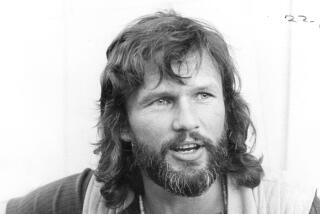It’s the Sid and Marty show
- Share via
Hollywood is often described as a dream factory, but really it’s just as often a salvage yard. Anxious studio executives would rather bet their $100-million budgets on nostalgia than on new ideas, which is why, against all odds, Sid and Marty Krofft are back in business.
The Krofft brothers, both now in their 70s, have a showbiz story that dates back to the final days of vaudeville. But for children of the Nixon years, their name is the brand behind some of the era’s strangest TV programming: shows such as “H.R. Pufnstuf,” “Lidsville,” “Land of the Lost” and “Sigmund and the Sea Monsters.”
Those low-budget shows had rubber-costumed actors, fluorescent puppets and psychedelic sets that were by the 1980s hopelessly dated; and by the end of that decade, the same could be said of the Kroffts.
Today, though, thanks to the Hollywood appetite for all things kitschy and high-concept, the Kroffts are poised for the biggest payday of their career -- unless, of course, they strangle each other first.
“Things did get lean, but we never gave up,” said Sid, 78, the smiling, soft-spoken dreamer of the two.
His brother, sitting next to him at their Studio City office, rolled his eyes. “We? I wouldn’t let you give up,” snapped Marty, still the deal maker at 71. “I wouldn’t let us sell the rights to our old shows. That is why we are where we are today.”
And where they are isn’t a bad place to be. Universal Pictures has just finished principal photography on a $100-million adaptation of “Land of the Lost,” the mid-1970s Krofft show about a family stranded in a jungle teeming with dinosaurs and hissing reptile-men called Sleestak. The remake is a comedy starring Will Ferrell, and Universal has circled it as its big popcorn movie for summer 2009. The Kroffts -- who will speak about the franchise today at the Comic-Con gathering in San Diego in front of 6,000-plus fans -- will get a percentage of the profits and make a mint from licensing deals.
The Kroffts, however, are bickering all the way to the bank, which is no surprise.
“To hear Marty talk, I’ve never worked a single day,” said Sid, who at age 15 joined the Ringling Brothers circus as a puppeteer and proved so adept that he would go on to become an opening act for the Andrews Sisters, Judy Garland and Cyd Charisse. Marty had joined the act by the late 1950s, and from then on the two puppeteers were locked in a contest to prove who was really pulling the strings. Sid was the creative force, but Marty was the one who made sure the act actually made it to the stage.
“Oh, I’ve earned my pay, believe me,” Marty said. “It’s not easy for two brothers to work together.”
An example came up almost immediately. Sid was sharing one especially windy tale when his brother groaned, “Sid, I thought you were telling a story about ‘Land of the Lost.’ What happened to that?”
“I’m getting there, Marty,” Sid said. “You know I can tell long stories too, just the way you do.”
Marty answered through a clenched smile: “That wasn’t very nice.”
A few minutes later, Sid decided to clear his conscience by revealing a 50-year-old family secret -- “We’ve been living with this lie for decades,” he said -- and his younger brother was apoplectic. “Now?! This moment, right now, you decide you need to tell all of this?”
Sid, the man who dreamed up deliriously strange Saturday-morning characters such as Weenie the Genie, Horatio J. HooDoo and Cha-Ka the ape-boy, looked bewildered by his brother’s fury. “Well, Marty, I don’t see the harm. It’s history now.”
--
There are still plenty of young dreamers, oddballs and colorful hucksters in the entertainment industry, but, really, the modern corporate era has wiped away most of its greasepaint charm. In the flashbulb era, big stars were bigger and tall tales were taller.
For example, take the celebrated Krofft family history: Sid and Marty are supposedly fifth-generation puppeteers, dating to the opening of the Krofft Theater in the early 1700s in Athens. It is a truly amazing tale and cited in almost every article every written about them, and it’s the first line of their bio.
It is also not true. It was cooked up by a New York publicist in the 1940s. The brothers have carried it with them ever since, until Sid suddenly decided to clear his conscience in an interview for this story.
“It became a trap,” Sid explained, shaking his head. “I was telling Marty the other day how bad it is that some of his children even have heard it and believe it.”
There are other vivid moments in the Krofft biography that test credulity. Marty, for instance, says that Beatles manager Brian Epstein called him seeking tapes of “H.R. Pufnstuf” so the band could keep up to date on the psychedelic Saturday-morning show. Of course, Epstein died in 1967, two years before “Pufnstuf” went on the air.
But, at some point, subjecting the old Hollywood to too much Digital Age scrutiny becomes a crass exercise. Really, should the men who brought the world “Lidsville,” a live-action show about giant talking hats, be expected to keep real-world details straight?
Their father was actually a clock salesman. He took his family south from Canada to Providence, R.I., to find more opportunities. The family ended up in New York. Young Sid’s flair for puppet design and puppetry ended up opening a door for the whole family. His father joined him on tour -- which inspired the “fifth-generation” fib -- as “pretty much an apprentice,” Sid said. Father and son were performing in Paris when, back in New York, Marty rummaged through his older brother’s trunks and borrowed his puppets to begin making money on stage himself.
In 1958, the act was the Krofft brothers and the venue was the Flamingo Hotel in Las Vegas, where they were opening for Garland. The critics raved about the act but, when they took it on tour, Marty was haranguing his brother every night about the bottom line.
“My brother was getting $1,500 a week from Judy Garland, and it cost $2,000 a week to travel the act,” Marty said. “But always, Sid would spend what we made -- and more -- on the show.”
Sid smiled. “If we didn’t put everything in the shows, they wouldn’t have been as good as they were. . . . That’s all that people see, what’s up on the screen. That’s where the magic is.”
In 1961, they premiered an adults-only puppet show, “Les Poupees de Paris,” at a dinner club in Los Angeles called the Gilded Rafters. Mae West, Richard Nixon and Liberace were in the audience on opening night. Johnny Carson caught a performance and deadpanned that it was the only performance he had ever seen by “naughty pine.”
The Kroffts began renting out their puppet and production savvy. They designed stage productions for fairs and amusement parks, took corporate work from Ford and Coca-Cola, and did some work for Walt Disney as well. Marty had crossed paths with the entertainment icon in 1959; Marty was at the Polo Lounge having drinks with Charisse when Disney stopped by to chat and gave him a bit of advice.
As Marty remembers it: “He told me, ‘The one thing to remember is, don’t ever sell anything you create and always put your name above the title, whatever you do. They’ll fight you off from doing it, but stick to it.’ The only thing he didn’t tell me was how to save money.”
--
Afew weeks before the Studio City interview, Marty was roaming the set of “Land of the Lost” out near the Trona Pinnacles, the eerie tufa rock formations that jut up from the desert floor past Palmdale. The spires, formed beneath the water of an ancient alkaline lake, have been used as a Hollywood location dating back to the ‘60s TV series “Lost in Space.”
“Look at this place. I never thought I would live to see one of our shows become something like this,” Marty said as he shaded his eyes from the sun. He nodded toward the trailers, tents, cameras, sets, props and a small army of crew members. “They spend more in one day than we spent in a year of making our shows.”
That’s a common pattern these days. Any character ever featured on a child’s lunchbox is fair game for a big-budget Hollywood treatment. Superhero films, of course, are a full-on bonanza, with “The Dark Knight” setting box-office records by the day.
The movie adaptation of “Land of the Lost” looks like the last great hurrah for the Kroffts, but if you listen to Marty’s relentless pitch, the windfall is just the beginning. He said the Krofft library may now be worth as much as $25 million and could become “the next Marvel Comics,” a reference to the comic-book company that has watched its 1960s creations (Spider-Man, the X-Men, Iron Man, etc.) take flight as 21st century blockbuster films.
“The Krofft era,” Marty declared, “is starting right now.”
Perhaps, but not all the Saturday-morning shows in the Krofft library are easy fits as feature films. The brothers say they have a former writer for “The Simpsons” working on a script for “Sigmund and the Sea Monsters,” the show that had Billy Barty portraying a skittish little marine monster with tentacles (he resembled a pea-colored SpongeBob SquarePants with seaweed for hair) who is taken home by two boys. A movie could be a sort of meld of “E.T.: The Extra-Terrestrial” and “Splash,” the Kroffts hope.
Most of all, the brothers would love to make a feature film of “H.R. Pufnstuf,” the show Sid describes as “our first baby.” The plot was about a teen, portrayed by Oscar-nominated “Oliver!” star Jack Wild, who finds himself on Living Island (where everything -- houses, books, plants, candles -- can talk). He meets the title character, a rotund dragon, and matches wits with the shrill Wilhelmina W. Witchiepoo.
The brothers, by the way, deny the popular perception that they were gobbling major amounts of LSD while making the shows. “I’m a runner, and I thought of them during my runs on the beach at Santa Monica,” Sid said. “That’s where they came from.”
After watching Tim Burton’s “Charlie and the Chocolate Factory,” Marty knows who he wants to see wearing the witch’s crooked nose. “How great would Johnny Depp be as Witchiepoo? Maybe he’ll read this, right? Look, all we need is a star. And a story. Hey, you know what Michael Eisner has said about the Kroffts for years? He said, ‘The Kroffts always have one more show in them.’ ”
The Kroffts certainly were willing to try anything, and they went well beyond Saturday-morning shows. They launched the teeny-bopper variety show “Donny and Marie” for ABC in 1976 and a year later brought the cast of “The Brady Bunch” back on the air as stars of a variety show. That show was met with howls, but even worse was the infamous “Pink Lady and Jeff,” an NBC variety show built around the Japanese pop duo Pink Lady.
“The network made the deal and gave them the show,” Marty said, “but that’s when we found out that they really couldn’t speak English. That was a problem. But what can you do?”
The show must go on, and “Pink Lady” did -- for a few deliriously awkward episodes. The Kroffts bounced back -- their “Barbara Mandrell and the Mandrell Sisters” was a hit, teaming the country stars with Krofft puppets in the early 1980s.
But the tide was turning against them. The variety-show format was dying. They could no longer find a foothold with their live-action morning children’s programming; Saturday mornings by that point belonged to cartoons.
More than that, the business of TV had changed. The Kroffts were true independent producers; they had made their shows on their own (usually small) budgets and then brought the finished product to the networks. By the ‘90s, that model was outdated.
Plenty of people approached the Kroffts about buying their library, usually at fire-sale prices. They said no to every offer, even the one from pop superstar Michael Jackson.
“The biggest thing as an independent is to survive. No one else really survived out there,” Marty said. “Either they’re dead or they sold the company. We’re lucky.”
Sid still gets misty every time he meets some 40-year-old who recognizes his name and reminisces about talking flutes or gentle, goggle-eyed sea monsters. “There aren’t many things,” he said, “that we take in our lives and carry for so long.”
Marty nodded in agreement. The shows were lucky in love, he said, but not in lucre.
Maybe that will change now that the Kroffts, after five decades in a small spotlight, are getting a late-in-life chance at the big time.
“How much money are we going to make?” Marty asked. “I’m not counting anything. I just want to be alive when the picture opens. It opens July 17, 2009. Don’t forget to put the date in the story.”
--
More to Read
The biggest entertainment stories
Get our big stories about Hollywood, film, television, music, arts, culture and more right in your inbox as soon as they publish.
You may occasionally receive promotional content from the Los Angeles Times.










